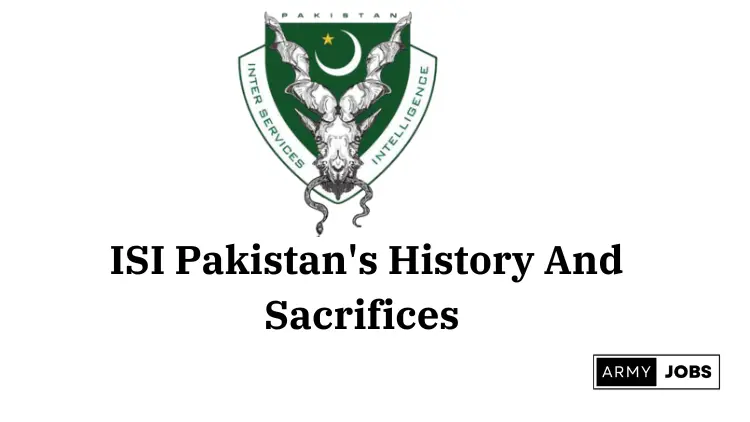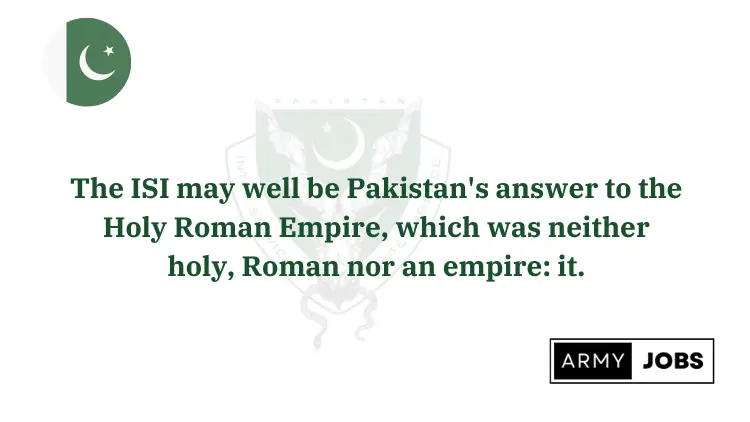The Inter Services Intelligence (ISI), known as the main pillar of Pakistan’s intelligence community, holds the responsibility of collecting, analyzing, and processing global information crucial for Pakistan’s national security. Answering to its director-general, the Inter Services Intelligence’s primary focus lies in furnishing intelligence to the Pakistani government.
Comprising mainly of military personnel from the Army, Navy, and Air Force, the Inter Services Intelligence, hence its name “Inter-Services,” also includes civilian recruits. Since 1971, the agency has been led by a three-star general appointed by the Prime Minister upon the Chief of Army Staff’s recommendation, who suggests three candidates for the role. As of March 2024, Lieutenant General Nadeem Anjum heads the ISI, reporting directly to both the Prime Minister and the Chief of Army Staff.

The ISI gained international prominence in the 1980s for supporting Afghan mujahideen against the Soviet Union during the Soviet–Afghan War. Collaborating closely with the CIA and MI6, it orchestrated Operation Cyclone, a program to train and finance Afghan mujahideen, with backing from countries like China and Saudi Arabia.
In the 1990s Afghan Civil War, the Inter Services Intelligence (ISI) provided strategic support to the Taliban against the Northern Alliance. With strong ties to jihadist groups, particularly in Afghanistan and Kashmir, its Covert Action Division spearheads special warfare operations. Notably, the FBI acknowledged in 2011 that the ISI sponsors and oversees insurgency in Kashmir, supporting separatist militant groups.
History Of Inter Services Intelligence
The Inter Services Intelligence (ISI) was established in 1948 following the first Kashmir war, which exposed deficiencies in intelligence gathering and coordination among Pakistan’s military branches, Intelligence Bureau (IB), and Military Intelligence (MI).
Initially conceived by former British Indian Army major general Sir Robert Cawthome and implemented by Colonel Shahid Hamid, the Inter Services Intelligence (ISI) focused on external intelligence collection, analysis, and assessment, with officers from the military services leading its operations. Naval commander Syed Mohammad Ahsan played a pivotal role in recruitment and expansion.
After the 1958 coup detat, all national intelligence agencies came under direct control of the president and Chief Martial Law Administrator, consolidating power under the Ayub regime. TheInter Services Intelligence’s role expanded during Operation Fair Play in 1977, targeting political parties.
During the Soviet–Afghan War in the 1980s, the ISI’s covert operations intensified, including support for mujahideen fighters in Afghanistan. While allegations of ISI support for militant groups persist, they remain contested. The Inter Services Intelligence (ISI) has been implicated in several major terrorist attacks in India, including the 2008 Mumbai attacks, and accused of supporting Taliban forces and recruiting mujahideen for conflicts in Afghanistan and Kashmir.
General Javed Nasir admitted to supporting various groups, and the Inter Services Intelligence’s influence extends to the National Intelligence Coordination Committee (NICC), overseen by the Director-General of Inter Services Intelligence, established in November 2020 for intelligence coordination.
Departments
There are following Departments of Inter Services Intelligence (ISI) and it’s operations and it’s active date.
Covert Action Division
This division, akin to the CIA’s Special Activities Division, has operated actively since the 1960s, with select officers trained by the CIA.
Joint Intelligence X
Serving as a hub, this department coordinates information from other Inter Services Intelligence (ISI) branches. Data gathered is processed here to generate reports for further analysis.
Joint Intelligence Bureau
Responsible for gathering intelligence on anti-state activities, counterfeit goods, counterfeit currency, and TTP involvement.
Joint Counterintelligence Bureau
In this department of Inter Services Intelligence (ISI) agents focuses on monitoring and countering foreign intelligence agencies’ activities.
Joint Intelligence North
Exclusive jurisdiction over Jammu and Kashmir and Gilgit-Baltistan, overseeing intelligence operations in the region.
Joint Intelligence Miscellaneous
In this department of Inter Services Intelligence (ISI) engages in espionage activities, including offensive operations in foreign countries.
Joint Signal Intelligence Bureau
Manages intelligence collection along the India-Pakistan border, specializing in ELINT, COMINT, and SIGINT to intercept non-communication electromagnetic radiation.
Joint Intelligence Technical
In this department of Inter Services Intelligence (ISI) tasked with advancing Pakistani intelligence capabilities through scientific and technological development, particularly in countering electronic warfare threats. Comprising engineer officers and military scientists, this division also oversees explosives and chemical and biological warfare sections.
SS Directorate
Staffed by officers from the Special Services Group, it monitors terrorist activities targeting Pakistan and conducts special operations against terrorist groups, akin to the FBI’s National Clandestine Service (NCS).
Political Internal Division
Historically involved in monitoring and funding right-wing political factions against left-wing counterparts during elections. Inactive since March 2012 under the new director-general’s leadership.

Headquarters
The ISI’s headquarters, located in Islamabad, Pakistan’s capital, comprises several low-rise buildings surrounded by lush lawns and tranquil fountains. Accessible through an unassuming entrance adjacent to a private hospital, the compound maintains a discreet aura, with plainclothes officers overseeing security measures.
Described by Declan Walsh of The Guardian as akin to a well-funded private university, the complex boasts meticulously maintained buildings, smooth lawns, and serene fountains. The central building, housing the director general’s office atop, is characterized by its modern architecture, featuring a spacious, echoing lobby.
Recruitment and training
Both civilians and members of the armed forces have the opportunity to join the Inter Services Intelligence (ISI). Civilian recruitment is managed by the Federal Public Services Commission (FPSC), and candidates are designated as employees of the Ministry of Defence. The FPSC administers exams evaluating candidates’ knowledge of current events, English proficiency, and analytical skills.
Shortlisted candidates undergo initial background checks conducted by the Inter Services Intelligence (ISI) before being invited for interviews. Interviews are conducted by a joint committee comprising ISI and FPSC officials. Successful candidates proceed to the Defence Services Intelligence Academy (DSIA) for six months of training.
Following training, candidates are assigned to different sections for open-source information duties, serving for five years. Upon completion of this period, officers assume more sensitive roles and become integral members of the ISI’s core team.
Major operations
There are following Major operation by Inter Services Intelligence (ISI) in Pakistan:
In past, the Inter Services Intelligence (ISI) faced allegations regarding its involvement in the Mehran bank scandal, where Yunus Habib, the owner of Mehran Bank, allegedly provided large sums of money to high-ranking ISI and Army officers to deposit the ISI’s foreign exchange reserves in his bank.
In 1980, the Inter Services Intelligence (ISI) uncovered a plot to assassinate Zia-ul-Haq and stage a coup to replace the government with an Islamic regime. Led by Major General Tajammal Hussain Malik and others, the conspiracy was planned during the annual Pakistan Day Parade on March 23, 1980.
Although the Inter Services Intelligence (ISI) initially refrained from arresting the conspirators, extensive surveillance allowed them to apprehend the key figures before the coup could be executed.
In 1985, the ISI’s Internal Political Division faced accusations of orchestrating the poisoning of Shahnawaz Bhutto, brother of Benazir Bhutto, in an alleged attempt to dissuade her from challenging Zia-ul-Haq’s military government. However, no conclusive evidence linking the Inter Services Intelligence (ISI) to the incident has been found.
The ISI’s failure to prevent the KHAD/KGB terror campaign in Pakistan in 1987 resulted in significant loss of life. Similarly, the 1990 elections were marred by allegations of ISI interference to favor the Islami Jamhoori Ittehad (IJI) party, orchestrated by Lieutenant General Hameed Gul, aiming to undermine the Pakistan Peoples Party (PPP).
In the 2000s, the ISI played a crucial role alongside Pakistan’s armed forces in combating the Tehrik-i-Taliban Pakistan during the War in North-West Pakistan, sustaining casualties in the process.
In 2006, Rangzieb Ahmed filed a civil claim against MI5, alleging that the ISI arrested and tortured him, collaborating with MI5.
In 2011, the ISI arrested five Pakistanis working as CIA informants, one of whom was linked to the intelligence operation leading to the death of Osama bin Laden. Despite US pressure to release Shakil Afridi, who aided in locating bin Laden through a fake vaccination campaign, the Pakistani government refused, and Afridi was subsequently sentenced to prison.
Al Qaeda and Taliban militants captured
Al Qaeda, established in 1988 by Osama bin Laden, is a global terrorist group that embraces radical Islamism. Meanwhile, the Taliban emerged in the 1990s in Afghanistan as a religious movement striving to implement Islamic law.
While seizing control of Afghanistan, the Taliban also provided support to Al Qaeda. Both organizations have left a significant impact on global terrorism and the political landscape of Afghanistan.
Ramzi Yousef
Notorious for his involvement in the 1993 World Trade Center bombing and the Bojinka plot, Ramzi Yousef was apprehended by Pakistani intelligence and U.S. Diplomatic Security Service Special Agents in Islamabad, Pakistan, on 7 February 1995, during a raid at the Su-Casa Guest House.
Ibn al-Shaykh al-Libi
A Libyan paramilitary trainer linked to Al-Qaeda, al-Libi attempted to flee Afghanistan after the Taliban’s collapse in November 2001. Pakistani forces captured him, precipitating the 2001 U.S. invasion of Afghanistan.
Ahmed Omar Saeed Sheikh
A British-born terrorist of Pakistani descent, Sheikh was arrested by Pakistani police on 12 February 2002 in Lahore for his involvement in the Pearl kidnapping case. Despite claiming he had surrendered to the ISI a week earlier, he was named the chief suspect.
Abu Zubaydah
Responsible for orchestrating various terrorist plots, including an attempted attack on Los Angeles airport in 2000, Zubaydah was captured on 28 March 2002 by ISI, CIA, and FBI agents during raids on safe houses in Faisalabad, Pakistan.
Ramzi bin al-Shibh
Known for his role in planning the 9/11 terrorist attacks and other bombings, bin al-Shibh was apprehended by the ISI during a raid in Karachi on 11 September 2002.
Khalid Sheikh Mohammed
Considered the mastermind behind the 9/11 attacks and numerous other terrorist plots, Mohammed was captured by ISI, CIA’s Special Activities Division, and Diplomatic Security Service Special Agents in Rawalpindi, Pakistan, on 1 March 2003.
Abu Faraj Farj al-Liby
Alleged mastermind of two failed assassination attempts on President Pervez Musharraf’s life in May 2005.
Maulvi Omar
A senior aide to Baitullah Mehsud, Omar was captured by the ISI in August 2009.
Abdul Ghani Baradar
Taliban’s deputy commander, Baradar was captured by Pakistani intelligence forces in or near Karachi, Pakistan, in early 2010.
Losses Made By Inter Services Intelligence
Since Pakistan initiated offensives against Al-Qaeda, the Taliban, and other jihadist groups, the country’s armed forces, intelligence services (particularly the ISI), military industrial complexes, paramilitary forces, and police have faced relentless attacks.
The ISI has played a pivotal role in targeting these groups, resulting in retaliatory strikes against it. As of 2011, over 300 ISI officials have lost their lives in these confrontations. Notable incidents targeting the ISI include:
On 28 November 2007, a suicide bomber rammed his vehicle into a bus carrying officials outside the ISI office in Rawalpindi, killing at least 28 people.
Three assailants attacked the ISI office in Lahore on 27 May 2009, resulting in the deaths of 30 individuals, including four ISI officials and 14 policemen, and injuring over 300. The attackers fired at the ISI office, while guards retaliated, leading to an explosion caused by an explosive-laden vehicle.
A suicide bomber detonated his van at the ISI’s Peshawar office on 13 November 2009, killing at least 13 people and 10 military personnel and causing extensive damage to the building.
In Multan, on 8 December 2009, two attackers targeted the ISI office, resulting in the deaths of eight individuals and injuring 45 others. The assailants used 800–1,000 kilograms of explosives.
A car bomb exploded at a CNG station in Faisalabad on 8 March 2011, killing 25 people and injuring over 100. Although the nearby ISI office was purportedly the target, no ISI personnel were reported killed, with only one official sustaining injuries.
On 14 September 2011, three intelligence officials were killed and one wounded in an ambush targeting a vehicle carrying agency personnel in FR Bannu.
In Sukkur, on 24 July 2013, five suicide bombers attacked the local ISI office, resulting in the deaths of four individuals, including ISI officials, and injuring 35 others.